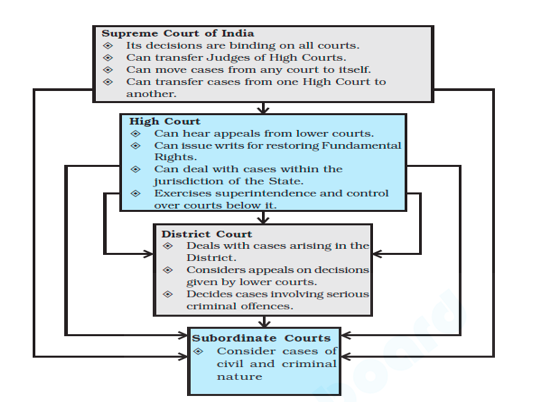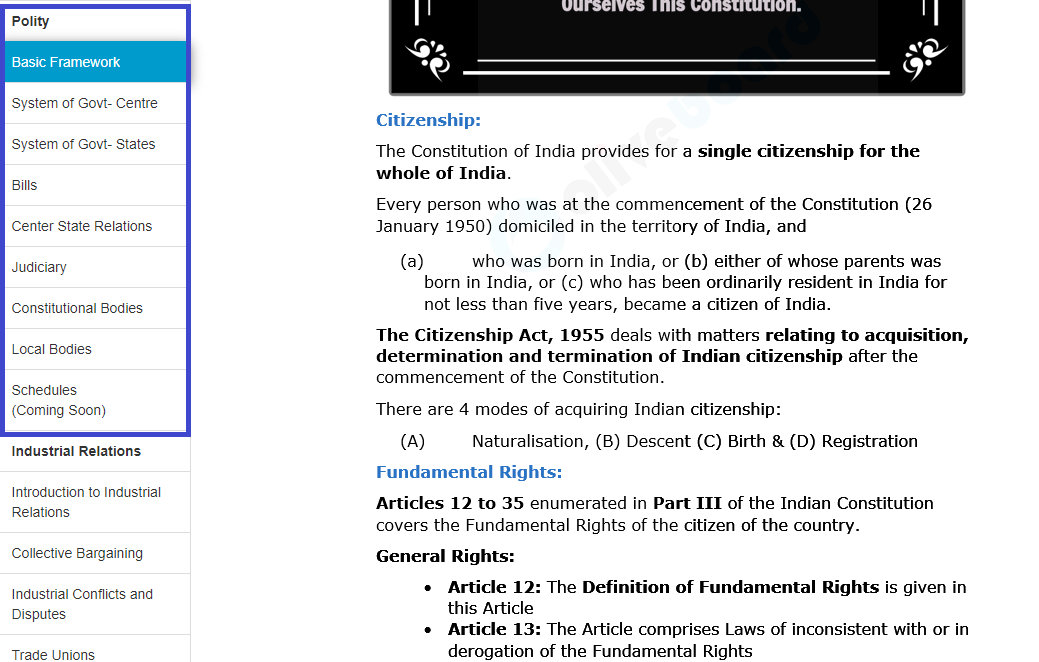UPSC EPFO EO Polity Notes – If you are preparing for UPSC EPFO EO 2020 then you are at the right place. The recruitment test is to be conducted on 4 October 2020. So you have enough time to prepare for the examination and due to the coronavirus outbreak, you can give a lot of time to your preparation. To help you with your preparations we have brought you a brief UPSC EPFO EO Polity Notes. Before moving forward take a free mock test here to test the level of your preparation and get an idea of the questions being asked.
Let’s start with the blog
UPSC EPFO EO Polity Notes
Historical Evolution
In order to know about the Indian political structure, it becomes very important to know about the Indian Constitution. There are various rules and Acts which were passed before independence which plays a vital role in shaping our Constitution. Some of the important historical events are listed down below:
- Regulating Act of 1773
- Amending Act, 1781
- Pitt’s India Act, 1784
- Charter Act, 1813
- Charter Act, 1833
- Charter Act, 1853
- Government of India Act, 1858
- Indian Councils Act, 1861
- Indian Councils Act, 1892
- Indian Councils Act, 1909 (Morley-Minto Reforms)
- Government of India Act, 1919 (Montague-Chelmsford Reforms)
- Government of India Act, 1935
- Indian Independence Act, 1947
Preamble: An Introduction to India Constitution
The preamble sets out the guiding purpose, principles, and philosophy of the Indian Constitution. Prime Minister Jawahar Lal Nehru approached Shri Behari with the proposal of handwriting it in a flowing italic style. Nandalal Bose and his students designed the borders of every page and adorned it with beautiful art pieces.
By 42nd Constitutional Amendment, 1976, it was amended which determined to constitute India into a Sovereign, Socialist, Secular and Democratic Republic. It secures justice, liberty, equality to all citizens of India and promotes fraternity amongst the people.
2.1 Objectives
- Description of Indian State as Sovereign, Socialist, Secular, Democratic Republic.
- Provision to all the citizens of India i.e.,
- Justice – social, economic, and political.
- Liberty – of thought, expression, belief, faith, and worship.
- Equality – of status and of opportunity.
- Fraternity – assuring the dignity of the individual and unity and integrity of the nation
Fundamental Rights
Features of Fundamental Rights
- Some of them are available only to the citizens while others are available to all persons whether citizens, foreigners or legal persons like corporations or companies.
- The Constitution confers the following rights and privileges on the citizens of India (and denies the same to aliens):
- Right against discrimination on grounds of religion, race, caste, sex or place of birth (Article 15).
- Right to equality of opportunity in the matter of public employment (Article 16).
- Right to freedom of speech and expression, assembly, association, movement, residence and profession (Article 19).
- Cultural and educational rights (Articles 29 and 30).
- They are not absolute but qualified.
- Some of them are negative in character.
- They are justiciable, allowing persons to move the courts for their enforcement, if and when they are violated.
- They are not sacrosanct or permanent.
- Most of them are directly enforceable (self-executory) while a few of them can be enforced on the basis of a law made for giving effect to them. Such a law can be made only by the Parliament and not by state legislatures so that uniformity throughout the country is maintained (Article 35).
Articles 12 to 35 enumerated in Part III of the Indian Constitution covers the Fundamental Rights of the citizen of the country.
General Rights:
- Article 12
- Article 13
Right to Equality:
- Article 14
- Article 15
- Article 16
- Article 17
- Article 18
Right to Freedom:
- Article 19
- Article 20
- Article 21
- Article 22
Right Against Exploitation:
- Article 23
- Article 24
Right to Freedom of Religion:
- Article 25
- Article 26
- Article 27
- Article 28
Cultural and Educational Rights
- Article 29
- Article 30
- Article 31
Saving of Certain Laws
- Article 31
Right to Constitutional Remedies
- Article 32
- Article 33
- Article 34
- Article 35
4. System of Government – Centre
Facts about parliament
How many sessions of the Lok Sabha are held in a year?
Normally 3 sessions are held in a year, viz.,
- Budget Session: February – May
- Autumn or Monsoon Session: July – August
- Winter Session: November – December
Article 85 only requires that there should not be a gap of more than 6 months between two sessions of parliament.
5. System of Government – States
Inter-state relation of India
While Ar. 131 provides for the judicial determination of disputes between States by vesting the Supreme Court with exclusive jurisdiction in the matter, Ar. 262 provides for the adjudication of one class of such dispute by an extra-judicial tribunal, while Ar. 263 provides for the prevention of inter-state disputes by investigation and recommendations by an administrative body.
Constitutional provisions related to Inter-state relations:
- Adjudication of inter-state water disputes – Ar. 262
- Coordination through inter-state council – Ar. 263
- Mutual recognition of public acts, records, and judicial proceedings – Ar. 261
- Freedom of inter-state trade, commerce, and intercourse – Ar. 301
6. Bills
- Bill is a proposal for a new law, or a proposal to change existing law.
- When a bill is passed in the Parliament and later receives the President’s assent, it becomes an Act.
- The bills can be broadly categorized into 4 types based on their purpose.

4. Bills are also categorized as Private Bill (introduced by a Private Member) and Public Bill (introduced by a Minister).
7. Centre-State Relations
Constitution of India has provided provisions to regulate the relations between Centre and States. It can be classified under three broad heads:
I. Legislative Relations:
Article 245 to 255 in Part XI of the constitution deals with legislative relations.
- Territorial Extend
- Parliamentary Legislations in the State
II. Administrative Relation
Article 256 to 263 in Part XI of Constitution deals with administrative relations.
- Obligations of State and the Centre
- Centre’s Direction to the state
- Mutual Deligations and Functions
- Cooperation Between the Centre and States
- All India Services
- Public Service Commission
- Other Provisions
III. Financial Relations
Article 268 to 293 in Part XII of the Indian Constitution deals with Financial relations.
- Goods and Service Tax mechanism
- Taxing Powers
- Grants-in-Aid to the states
- Statutory Grants
- Discretionary Grants
- Finance Commission
- Borrowing by the Centre and the States
- Inter-Government Tax immunities
Committee on centre-state relations:
- Rajamannar Committee
- Sarkaria Commission
- Punchhi Commission
8. Judiciary
Indian constitution has established an integrated judicial system adopted from the Government of India Act, 1935. The act enforces both Central and State Laws.
Independence of Judiciary in India
It is ensured through the following measures:
- Legislatures are not involved in the appointment of judges.
- Security of tenure provided to judges.
- Rigid process of removal of judges.
- Remuneration of judges and administrative expenses of Supreme Court and High Court judges are charged on Consolidated Fund of India and states respectively.
- Conduct of judges cannot be discussed in Parliament or state legislatures, expect when impeachment motion under consideration.
- Ban on practise of Supreme court judges after retirement.
- Supreme Court can punish for its contempt.
Structure of Indian Judiciary

9. Local Bodies
I. Panchayati Raj:
Panchayati Raj is the pan-India system of local self- governance entrusted with the responsibility of rural development.
Rajasthan was the first state to establish Panchayati Raj.
Many committees such as Balwant Rai Mehta Committee (1957), Ashok Mehta Committee (1977), GVK Rao Committee (1985), L M Singhavi Committee (1986) etc. were constituted to te strengthen the system.
73rd Amendment Act of 1992:
- This act added new Part-IX and Articles 243 to 243 ‘O’ and 11th Schedule to the constitution.
- This act gives the Constitutional Status to the Panchayati Raj Institutions (PRI)
- The act has been inspired by Article 40 of the constitution.
| Gram Sabha |
|
| Three-Tier System |
|
| Election of members and chairperson |
|
10. What We Have In Store For You?
1. 10 Mock Tests for EPFO EO in the latest pattern with detailed solutions
2. Summary Notes for all sections (except Quant, Eng)
- Indian Freedom Struggle (Click Here For Notes)
- Indian Polity and Economy (Click Here For Notes)
- General Accounting Principles (Click Here For Notes)
- Industrial Relations and Labor Laws (Click Here For Notes)
- General Science and Knowledge of Computer Applications (Click Here For Notes)
- Social Security in India (Click Here For Notes)

This was all from us in this blog UPSC EPFO EO Polity Notes. Hope the information provided above will help you in your exam preparation. Stay tuned for more exam related information.
All The Best For Your Exam Preparation!
- IBPS AFO Bank Wise Vacancy 2025 Out, Check Complete List
- SSC JE Previous Year Question Papers, Download the Free PDF
- IBPS AFO Bank Preference List 2025, Get Participating Banks List
- IBPS AFO Documents Required for Interview 2025, Complete List
- IBPS AFO Books 2025, Check Complete List of IBPS AFO Books
Frequently Asked Questions:
The age limit for UPSC EPFO exam is between 18 to 30 years for EO/AO and 18 to 35 years for APFC posts.
The initial salary of an UPSC EPFO EO is Rs. 44,900 per month.
There are no limits in attempting UPSC EPFO exam.
The required qualification for UPSC EPFO Exam is to have a Bachelor’s degree in any stream from a recognized university.
